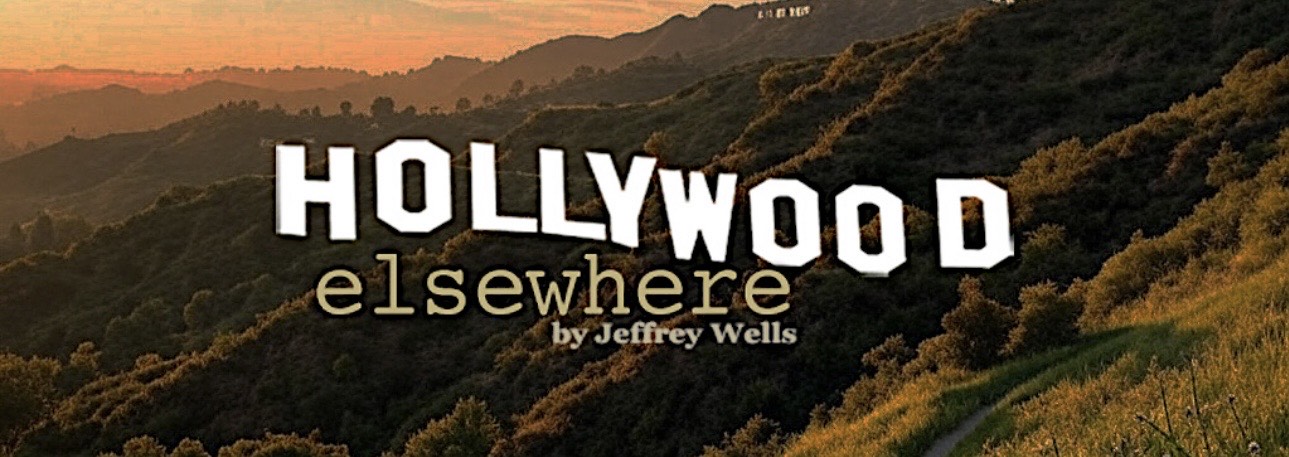Taxi Driver costars Jodie Foster, Robert DeNiro at the Cannes Film Festival, a bit less than 35 years ago. De Niro looks distinctly uncomfortable; Foster seems glassy-eyed but more or less accepting. Today’s De Niro is a tad mellower (naturally) but is still the same guarded guy, obviously still thriving and punching even though — let’s be honest — he creatively peaked as an actor years ago. Foster — 13 then, 48 now — has grown into my idea of a steady and together hyphenate, and her peak may be yet to come.
Day: April 24, 2011
"Pile-Up of Poor Judgment"
Before Jesse Peretz‘s My Idiot Brother had been retitled Our Idiot Brother (8.26) by the Weinstein Co., it was slammed at Sundance by Hollywood Reporter critic John deFore. The film, he said, “shambles along with all the purposefulness of its title character, a kind of near-beer Lebowski who’s neither reckless enough to cheer for nor misguided enough to disdain.
“Paul Rudd‘s Ned Rochlin, recently released from jail and broke, wanders through his three sisters’ homes, inadvertently revealing that each has as much to answer for as their brother who sold dope to a policeman in uniform. Each episode yields laughs, but the many parallel screw-ups don’t build to the kind of crescendo the film needs; it may be no worse than Rudd’s latest vehicle, How Do You Know, but it’s yet another leading role that fails to live up to Rudd’s talent, and it’s hard to imagine it approaching the commercial success of his more high-concept studio comedies.”
Talking Points
It’s already clear how Meryl Streep‘s Oscar-bait performance as Margaret Thatcher in The Iron Lady (20th Century Fox, late December) is going to be sold. One, as a tribute to a woman “who came from nowhere to smash through barriers of gender and class to be heard in a male-dominated world.” And two, as a respectful salute to a tough, steely conservative who doesn’t seem so bad compared to the Palin-Bachmann tea-bagger wackos.

Jim Broadbent (l.)as Denis Thatcher and Meryl Streep as Margaret Thatcher in Phyllida Lloyd’s The Iron Lady.
Oldie Bluray Short List
Yesterday I posted a fairly glum assessment of the fate of classic films on Bluray, but you can’t get too down-hearted about this stuff. So here’s a list of 30 films made (and for the most part released) in the 1950s — most of them large-format, nearly all in color — that need to be properly spiffed up and Bluray-ed. They certainly need looking after element-wise, particularly those released in the mid to late ’50s up until ’60 due to fading among those shot on “safety” stock.
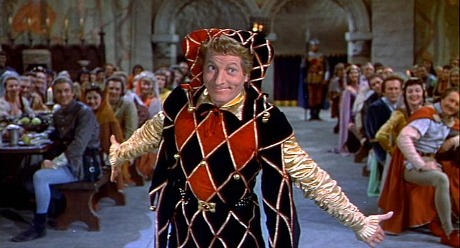
Danny Kaye in The Court Jester
It doesn’t matter if decent-looking DVDs of these films exist — they could all look much better and need to be re-done to satisfy the Movie Godz. If these films were properly restored and remastered for Bluray release we’d all be living fuller, happier lives.
One guy who helped me put this list together is Bruce Kimmel, former director (The First Nudie Musical), a motion-picture soundtrack record producer and a rabid film aficionado.
I need to mention the VistaVision problem before starting. Paramount shot and released over 100 VistaVision films in the ’50s, and so far we’ve only seen two of them properly transferred to Bluray — The Ten Commandments and White Christmas. It would be ecstasy if the original VistaVision version of Marlon Brando‘s One-Eyed Jacks (’60), a beautifully-shot western that’s has been mired in public-domain hell for several years, could be released on Bluray.
With three or four exceptions I’ve included large-format films that should play by today’s standards, and have avoided those that probably certainly wouldn’t work on Bluray due to being mediocre or awful by any measure.
1. William Wyler‘s The Big Country (’58…shot on SuperTechnirama, a horizontal 8-perf VistaVision-like format that renders a horizontally-squeezed image that came out un-squeezed at a 2.35-to-1 Scope ratio when projected anamorphically). The DVD of this Gregory Peck-starring western is so-so, nothing special, close to mediocre — a properly-rendered Bluray would be stunning.
2. Alfred Hitchcock‘s The Man Who Knew Too Much (’56…shot in VistaVivision). “The original negative has faded, and the two Universal Home Video DVDs so far have been blah-level. “It could and should be gorgeous…perfect,” says an east-coast source.

The Man Who Knew Too Much
3. Melvin Frank and Norman Panama‘s The Court Jester (56…shot in Vista Vision.). I’ve never even seen this film, mainly because I have an aversion to Danny Kaye. (Horrific images of Kaye coupling with Laurence Oliver flood my brain, etc.) A medieval spoof, gorgeously photographed. “The one Danny Kaye film that never dates,” says Kimmel.
4. Michael Todd‘s Around the World in 80 Days (’56…one of two films shot in 30-frame Todd-AO). A close-to-ghastly film that needs work, research, restoration. A film shot in 65mm 30 fps has to be saved, no matter how bad! Compared to what it should look like, given the exceptional elements, the DVD looks awful, bordering on out-of-focus. And yet the fact that it won the 1956 Best Picture Oscar (i.e., handed out in ’57) is perhaps the Academy of Motion Picture Arts and Sciences’ greatest embarassment.
5. John Wayne‘s The Alamo (’60…shot in 70 mm Todd-AO).
6. John Huston‘s Moulin Rouge (’52). Shot by dp Oswald Morris in reddish rosey tones as a kind of visual experiment meant to complement the color in the paintings of Toulouse Lautrec. Allegedly never rendered on DVD befitting Morris and Huston’s precise intentions.
7. John Huston‘s Moby Dick (’56). Shot and processed by Morris in washed-out color and rendered in release prints that were printed with a “gray” negative which gave the color a certain black-and-white tonality meant to resemble Currier & Ives etchings. This special color experiment has been simulated on the Moby Dick DVD, but it’s not the real thing, of course. I happened to see a single reel of a ’56 black-and-white release print at the Academy back in the ’80s — riveting.
8. William Wyler‘s Roman Holiday (’53). Lowry Digital’s John Lowry delivered a grain-free DVD in 2002. “It was a low resolution DVD made from the wrong elements,” a source remarks. “It was the same thing with Sunset Boulevard…they couldn’t find the original negatives or the original fine-grain on either one…it didn’t look filmish…it looked like a ‘kinny'” — i.e, a kinescope.
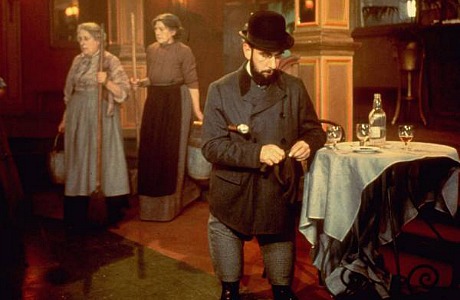
Moulin Rouge
9. Billy Wilder‘s Sunset Boulevard (’50). See Roman Holiday.
10. Billy Wilder‘s Stalag 17 (’53).
11. Vincent Minnelli‘s Gigi (’58). “They did everything they could [when they mastered the Bluray] but they were dealing with a faded original negative and bad color.”
12. John Ford‘s The Searchers (’56). “Needs to be re-done,” says Kimmel. “The Bluray is sharp but the color is wrong…they put too much yellow into it. Everything is wrong….Monument Valley sand is wrong….the sky is faintly greenish when it should blue….the clarity is fantastic but the adobe bricks in the opening credits are supposed to be gray but they’re blondish gold.”
13. George Stevens‘ Shane (’53). “It could be done like they did The African Queen and The Red Shoes, a beautiful Bluray done by Bob Gitt. They have a three-strip Technicolor negative…they just don’t have a clean HD master so how are they going to bring it out on Bluay?…it’s not a huge undertaking…but they just need to buckle down and go in that direction.”
14. Fred Zinneman‘s Oklahoma! (’55, shot in 65mm Todd AO 30 frame and also in 35mm 24-frame — two different versions). Kimmel, like me, saw Oklahoma! projected in 30-frame Todd-AO at the old DGA theatre back in the mid ’80s. “It was beautiful…you felt as if you could walk right into that picture,” he says. A laser disc that delivered the Todd AO version was sharp and handsome but for whatever reason the same version looks atrocious on the DVD. Kimmel says that Fox Home Video restoration maestro Schawn Belston believes that “the image compression screwed it up” and that the Todd AO version is salvagable.
15. Otto Preminger‘s Exodus (’60). A mediocre film shot in 70 mm that looked awesome when it was projected in first-run engagements some 51 years ago. “The DVD is the worst thing ever made and it’s a 4 x 3 transfer,” Kimmel remarks. “That’s one I’d love to see done right.” (Even if the film itself is quite difficult to sit through, he could have added.)

Moby Dick
16. The three James Dean movies — Elia Kazan‘s East of Eden (’55, 35mm CinemaScope), Nicholas Ray‘s Rebel Without a Cause (’55, 35mm CinemaScope) and George Stevens‘ Giant (’56). “Giant is the worst of the three…the wrong process for the wrong film…they took the original Eastman negative and created a dye transfer print, which exacerbated all the problems….so they could say it was in Technicolor.”
17. Alfred Hitchcock‘s To Catch a Thief (’55, VistaVision). Paramount’s Centennial edition DVD, released in 2009, is the best-looking version of all, but just imagine how this exceptionally colorful thriller would look in Bluray.
18. Vincent Minnelli‘s Lust for Life (’56). Shot on Ansco, purportedly to get rid of the stock at hand.
19. Henry King‘s Carousel (’56), shot in CinemaScope 55mm, an eight-perforation process involving a slight horizontal blowup, the same process used on The King and I.
20. Edward Dmytryk‘s Raintree County (’57, shot in Camera 65mm, the process also used for Ben-Hur).
21. Joshua Logan‘s Sayonara (’57).
22. Stanley Donen‘s Funny Face (’57).
23. Morton DaCosta‘s Auntie Mame (’58, shot in Technirama — 35 mm anamorphic).
24. Richard Brooks‘ Cat on a Hot Tin Roof (’58, 35 mm).
25. Fred Zinneman‘s The Nun’s Story (’59, 35 mm).
26. Otto Preminger‘s Porgy and Bess (’58, Todd AO 65mm, 24 frame).
27. Fred Zinneman‘s The Sundowners (’60, 35mm).
28. Richard Brooks‘ Elmer Gantry (’60).
That's The Idea
Awards Daily‘s Sasha Stone and I have agreed to rent a car sometime in the afternoon on the day before the start of the Cannes Film Festival (i.e., Tuesday, May 10th) and drive into the hills above Cannes and Nice and maybe stop for a bite in Saint Jeannet, the smallish village seen from the home belonging to Cary Grant‘s John Robie in To Catch A Thief.
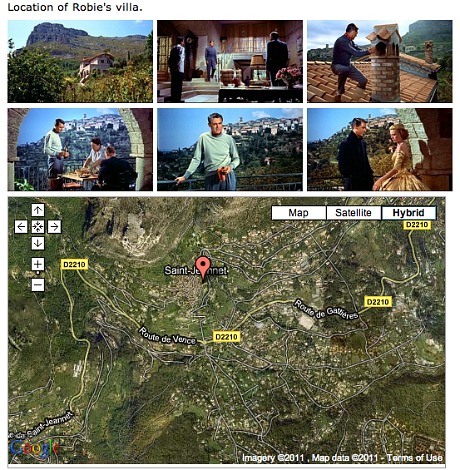
That Act One chase scene (cops in black car chasing Robie’s marooon convertible) in Alfred Hitchcock’s 1955 film is the basic inspiration — i.e., to take the same drive along those winding roads and scenic rocky cliffs. (I’d also like to stop for a minute in Tourettes-sur-Loup.)
We’ll be leaving at 2 pm or thereabouts and returning to Cannes in time for the annual 7:30 pm journalist get-together at La Pizza. If anyone wants to tag along, get in touch. I’m figuring no more than a four-hour trip all together. Okay, five hours. Stone and I are arriving in Cannes fairly early that day so there will plenty of time to get situated and pick up our press passes and whatnot.
Mitchell's Latest Ankling
As I explained three weeks ago, mentioning that Jeffrey Wright‘s character smokes a pipe in a review of Source Code, however sloppy and unfortunate, is not a whackable offense. It’s certainly something that now-former Movieline critic Elvis Mitchell, whose firing was announced last evening by Nikki Finke, could have finessed with one hand tied behind his back.
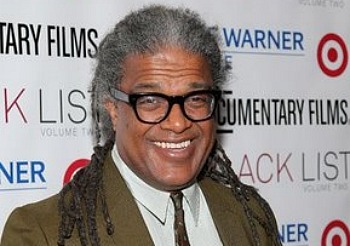
Former Movieline critic Elvis Mitchell
My guess is that Elvis didn’t respond to his employer (MMC’s Jay Penske) quickly enough with a reasonable-sounding explanation, or perhaps he doesn’t respond with any details at all. Because impersonating a black hole when it comes to responding to emails and phone calls is definitely what Mitchell does.
The “tell” is in this passage in Nikki Finke‘s story (which posted last night at 5:27 pm Pacific), to wit: “After the director’s tweet was brought to Movieline‘s attention, I questioned an editor there who emailed, ‘We’ve indeed been working hard for a week to ascertain exactly what happened…'”
Who works hard for a week to figure out an issue like this? You call or text and the employee responds…simple. Movieline editor: “So Elvis, what happened here?” Mitchell: “I don’t know. Fatigue or something. I read the script a while back and somehow the pipe-smoking thing found its way into my head. It happens. The brain does this on occasion. No biggie. I’ll write an apology and an explanation.” Movieline editor: “Cool.”
“When Movieline asked for a formal explanation,” Finke reports, “Mitchell told editors that he was at the screening and that it was all a misunderstanding and that he would provide a written explanation.” Except he apparently didn’t.
I wrote Mitchell this morning with the following message: “Can you PLEASE explain what the fuck happened with Movieline? I’m trying to write this up and the Jeffrey Wright pipe-smoking thing just ISN’T A FIRING OFFENSE. So what happened? Did they try to reach you and discuss this and you blew them off? This was an easily finessable thing.” And of course, no response.
Mitchell responded once to me via email when he left the NY Times film critic gig, or so I recall…but that was the exception. And you’d think he’d at least keep in touch with guys like me because he just keeps blowing, or blowing off, exceptionally cool gigs. The recent Roger Ebert movie-review co-hosting TV thing…phffft. That minority-filmmaker-scouting gig in Manhattan for Sony — a totally cushy job that he reportedly torpedoed by not showing up at the office. A director of development job at Paramount Pictures…blown. Right now he still has the NPR radio gig hosting “The Treatment” and…I forget what else.
I’m presuming that Mitchell not being quoted in Nikki Finke’s story was because he didn’t reply to her queries. Indiewire‘s Anne Thompson has written a knowledgable assessment. David Poland‘s take on this is worth reading. Roger Moore‘s Orlando Sentinel riff struck me as needlessly mean-spirited.
Bull-Headed
What kind of a raging butt-plugged Mussolini do you have to be to type “[Blogger X]” to avoid posting my name? MCN’s David Poland did this in the process of re-posting a short 4.20 Glenn Kenny/Some Came Running riff about a Times Square Starbucks installing wall outlet covers to keep people like me from sitting at their tables for hours on end.

I admire Poland for many things (particularly his take-no-shit responses to Nikki Finke), but every now and then he just floors you with his Zampano-like obstinacy.
I’m assuming, by the way, that Kenny’s experience describes the policy of just that one Starbucks he happened to be in. Because…whatever, the place has exceptionally high traffic and the manager is an asshole. It would be nothing less than a national five-alarm-bell tragedy if all Starbucks outlets were to install wall-outlet blockers. If there’s one thing you can count on at Starbucks cafes it’s the presence of at least two wall outlets. You can always plug in sooner or later, and that’s a truly wonderful and deeply appreciated thing.
